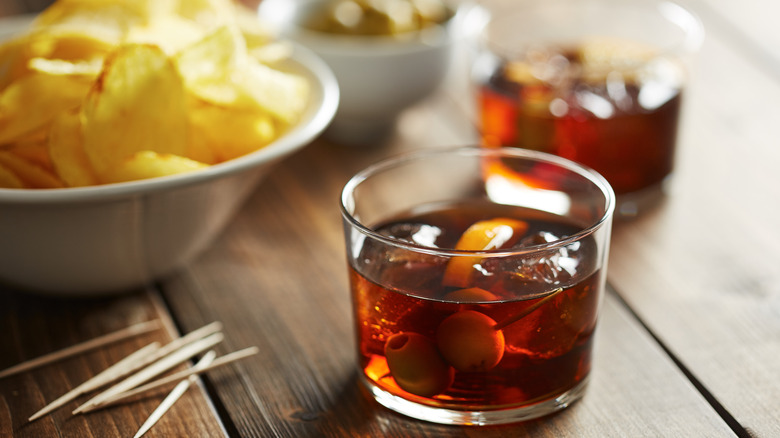Spain's Combinación Honors A Long-Established Cocktail Culture
Many cocktails are recent creations — first crafted inside innovative bars and enjoyed by curious drinkers. A select few turned into beloved modern classics and now appear on cocktail menus worldwide. However, mixology as a profession is over a century old, so it's understandable there some drinks have been nearly wiped out of fashion.
In Spain, one such cocktail is the Combinación, a sling that reached peak popularity in the 1950s-60s. Unfortunately, its consumption declined alongside the reduction of aperitivo culture, and the drink nearly disappeared. At the start of the 21st century, only a few historic bars still served it, until a recent resurgence once again revealed the Combinación's delicious appeal — thanks to the efforts of revered Viva Madrid bartender Diego Cabrera.
The drink starts with dry gin and vermouth, an aromatic and malleable base. The mix is complemented with bitters and a splash of an additional component like dry curacao or sherry. It's a classic Spanish concoction, tracing back to the country's love affair with vermouth that started in the 19th century. Taking on varying forms, it's a testament to a distinctly Spanish cocktail culture.
The Combinación emerged from Madrid's aperitivo culture
The cocktail traces its early stages to a burgeoning aperitivo culture, which emerged at the end of the 19th century. Taking on fashions from Paris and elsewhere in Europe, Spaniards opened daytime drinking cafes, which served vermouth, liquors, and later, cocktails. In the beginning, mixed drinks weren't a cornerstone of such establishments. However, bartenders — likely influenced by foreign visitors — began experimenting with mixed concoctions.
Sometime in the 1920s, the Combinación took hold, especially favored in Madrid. Bartenders would combine near equal parts of gin and vermouth for customers, and the drink's popularity grew. By the 1950s, the Combinación was one of the city's most popular creations. Similar slings with different ratios took hold in other Spanish regions, like in the Basque country, where the Marianito cocktail relies on more Campari than gin in addition to the vermouth backbone. The creation of such drinks showcased Spain's dynamic aperitivo drinking culture.
A few decades later, the Combinación faded to the point where "young bartenders in the Spanish capital didn't even know it," as José Andrés ThinkFood Group cocktail director Miguel F. Lancha recalled to Punch. However, with Diego Cabrera offering the drink at the renowned Viva Madrid, homegrown interest sprouted once more. So, if you find yourself in Spain, enjoy the concoction during an aperitivo that'll build your appetite. It's a historic drink with modern appeal.

